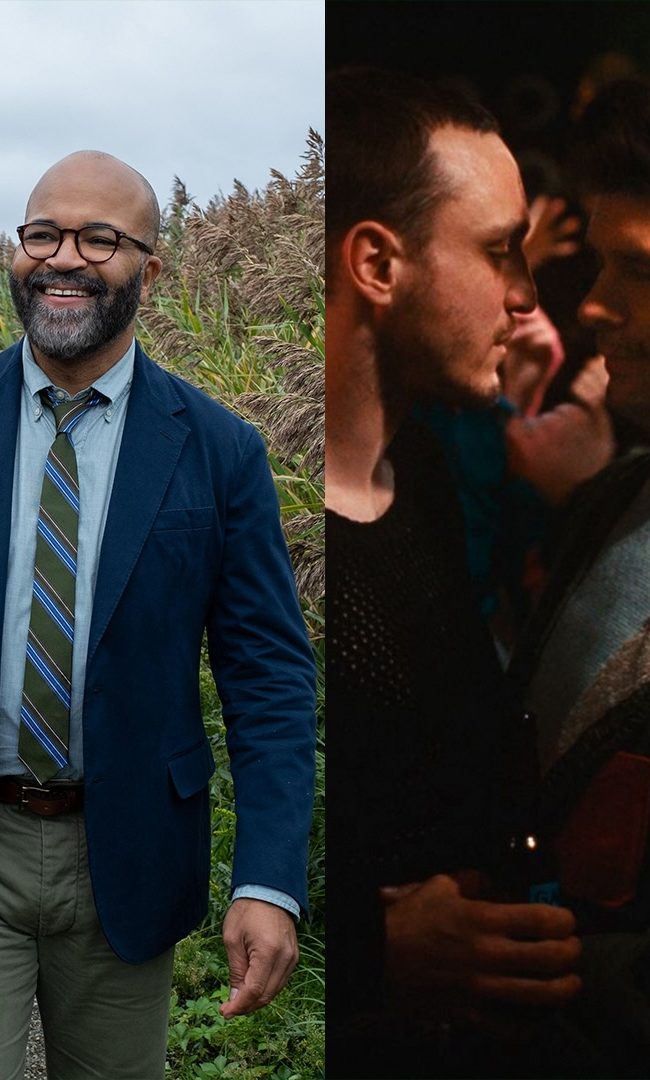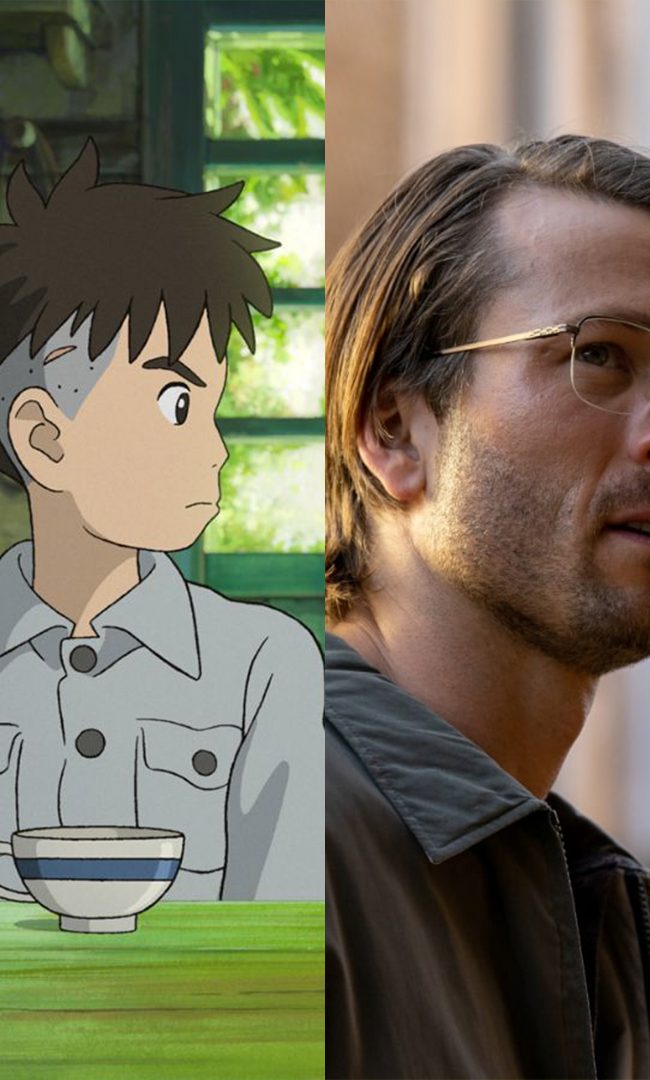A Conversation With Adam Keleman (EASY LIVING)
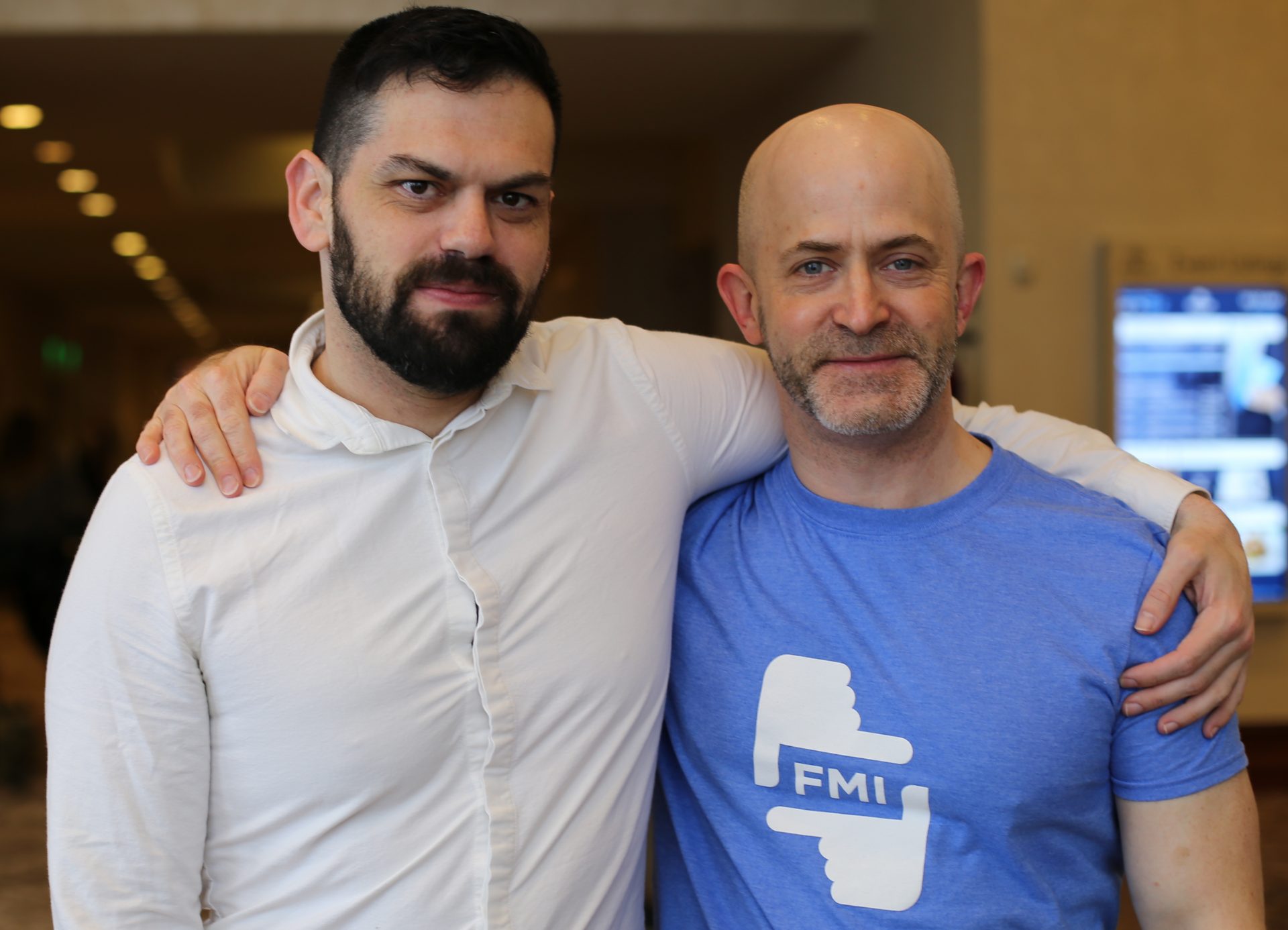
I met with writer/director Adam Keleman (winner of the 2012 Hammer to Nail short-film contest, for his movie Long Days) and his star, Canadian actress Caroline Dhavernas (Mars et Avril), separately, both on Monday, March 13, 2017, at SXSW, to discuss their collaboration on Keleman’s first feature, Easy Living (which I also reviewed). The film is a charming dramedy about a thirtysomething door-to-door makeup saleswoman, Sherry Graham, at a crossroads who cannot manage to change her self-destructive ways. Though at times bleak, the story never descends into the maudlin, thanks to Keleman’s deft writing and Dhavernas’ brilliant performance. Here is a condensed digest of each conversation, edited for clarity, first Keleman, followed by Dhavernas.
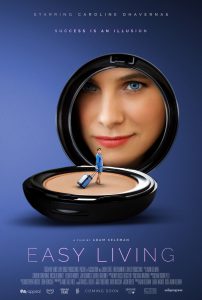 Hammer to Nail: So, I really liked the film, but on some level, it’s really quite sad, though lovely at the same time. What motivated this sweetly sad tale of Sherry.
Hammer to Nail: So, I really liked the film, but on some level, it’s really quite sad, though lovely at the same time. What motivated this sweetly sad tale of Sherry.
Adam Keleman: I think a lot of things were in the air in my mind, in the zeitgeist, and I really wanted to tell my own version of she’s like a female version of the main character in Death of a Salesman…
HtN: Willy Loman.
AK: She’s like my Willy Loman, in a way. (laughs) I wanted to tell a female version of someone trying to succeed in the world, who doesn’t really fit into a box. Obviously, Willy Loman was a suburban man and a salesman, but Sherry is kind of an outlier. She doesn’t have a husband, with two kids; she doesn’t live in a house with a white picket fence; and she also doesn’t have this 9-to-5 job; she’s kind of a little out of place, in a way; and somewhat of an orphan. I really wanted to explore how people who are a little bit on the fringe survive, or how are they trying to strive in the world and have a fulfilled life. And do they need all of that, too? Do they need those expectations?
HtN: I read, in the director’s notes, that you were influenced by the Maysles’ Salesman.
AK: Oh, yeah, of course! I mean, when I first saw that, I wondered what the female version of that was like. I love the Maysles, as well as Frederick Wiseman. They’re the pinnacle of documentary filmmaking. Originally, the premise of the film was going to be a lot more of these door-to-door makeup-selling moments, integrated throughout the film, and we actually were going to go knock on people’s doors anonymously and try to create these wacky, wild moments and see what happens. Kind of reality TV style. But I realized that would be really difficult to do, plus they’re so necessary to the film, and so we ended up casting some actors from Craigslist and some from Backstage, as well as local theater groups in New Jersey and on Long Island. And then we also found them through friends of the production, found non-actors, and most of the non-actors made the cut, because they had an authenticity and they weren’t trying. It’s just them, and it’s beautiful. So all those moments were all improvised, 100%. She created the flow of that dialogue …
HtN: “She” being Caroline Dhavernas.
AK: Yes! Caroline Dhavernas, who plays Sherry Graham, the lead, totally improvised every single word with those women. I gave her 10 questions to ask, but she riffed off them, and kind of led them in different ways. If some of the conversations weren’t as deep, I would tell some of the women, “Ask her a personal question. Dig in to her a little bit, and see what happens.”
HtN: And so did Caroline have a backstory already in place? Because at one she is asked about her childhood. Was that set, or was that improvisation?
AK: I never discussed her parents, her childhood with her, ever. We had maybe two conversations before she came, 30 minutes each. She was like, “I like this script. I’m gonna do it.” And literally, I was so nervous, because I’ve followed her career and I’ve seen almost everything she’s done, in the U.S., and I’m such a big fan, and I know what she can do, which is like anything. She has an incredible range, so I think that by bringing her on, I knew that I didn’t have to do much, but then once she came on and I saw that first door-to-door moment selling makeup, my mouth dropped, because I just saw her take the film, and I just let her. She created and established the tone of the film.
HtN: So those scenes are not scripted, so that’s really her leading the dialogue and coming up with answers on her own.
AK: Yes.
HtN: Wow.
AK: She never stopped once, unless I chimed in to say, “Go back to this.” But that was it. Because we filmed each woman for about 30 minutes, so a lot of stuff was brought up, and we picked just 30 seconds. But yeah, it was kind of incredible what meaty stuff we got, which I did not plan for, and it helps the narrative so much. It made the character so much richer.
HtN: Oh, I agree. In fact, that’s the heart of the film, in many ways. So you’re a first-time feature director. How did you put this all together, and how did you get an established actress like Caroline Dhavernas?
AK: Well, it’s a project I’ve been working on for the past 4 to 5 years. And there’s this great foundation called the Jerome Foundation, and they give grants in New York City and in a state in the Midwest – I think it’s Minnesota – and in 2013, they gave us a grant, and that helped with the momentum of the film. And then a casting director I’ve worked with before, on a short, would check in with me every year about the movie, asking “What’s going on?” And then by 2015, I was like, “I’m making this movie or I’m trashing this script,” and in April of that year I gave the script to that casting director, and we started sending it out to people in June or July, and when Caroline signed on, the whole film came together, in like a month.
HtN: And that was just through the usual process of getting it to her agent, somehow?
AK: Well, I had a connection to her agent. A friend of mine in New York was her agent’s assistant, and he knew about the project, and also my casting director knew him, too. And I think that helped. I think he prepared the way, you know, “Here’s the script! You’ll love it!” She liked one of my shorts a lot, and I think that sold her. And then, it was weird, I think it was Labor Day Weekend of September, 2015, and we gave it to her on a Friday, and then on Monday my casting director said, “She wants to talk to you!” And I said, “What?” It was just so fast. We had an interview – a Skype interview, because she lives in Montreal and I’m in Brooklyn – and within 5 minutes, she said yes, which I did not expect. I feel like I’m so used to doing the Hollywood process, which is so extended and long, and so I thought, “OK. We had this interview, now she’ll think about it for three months, and then get back to me.” But no. She said yes. She was just really anxious to do something meaty, no matter the budget, and just dive in to a character.
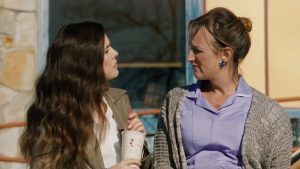
Caroline Dhavernas and Jen Richards
HtN: I think she’s perfect in the role. So beyond Caroline, who is phenomenal, and we’ve established that, how did you cast some of the other roles, especially Jen Richards, a trans actor? At some point I finally noticed her Adam’s apple and thought, “Oh, that’s interesting casting.” Because it’s never addressed, and I think she’s great. So what motivated your other casting choices, and Jen, in particular?
AK: In general, I think how I approached casting was that I wanted the world to be very much like our own, but one step removed. And when I was thinking of the best friend character, I thought, “We’ve seen this type of character all the time.” I just kept asking myself, “Why not?” And I didn’t know that many trans actors. I had a friend who worked on Transparent, and it’s hard, because he knows more actors in L.A., and it was just a hard process.
And then I saw Jen Richards. She made a web series called Her Story – which is really sweet, sad and really funny – which she wrote and co-produced and stars in. And she made it through Kickstarter. And on that Kickstarter video, I saw her and something hit me about her. It was just magnetic. You know, you can just tell, by the look, the feel, the tone of her voice. I thought, “This is the character of Danny.” And I just immediately tweeted at her, “Will you be in my movie?,” got no response, and deleted that tweet. (laughs) Because I just didn’t know how else to connect to her. I don’t know if she had an agent at that point. And then I told my casting director, “I think she’s the one,” and gratefully, it worked out.
We had to rearrange the schedule, because she does a lot of panels and talks, like all over the U.S., all the time, and so she would fly in for two or three days, fly out, and then come back to do one or two more days. But I’m so grateful, because I think she and Caroline have such great chemistry. They didn’t know each other beforehand, and they just rehearsed once, though they hung out one or two times before, but that was it.
HtN: And it does add another layer, if one is looking for that in what is, as you say, often a stock character. And I like the rest of your supporting players, as well. Let’s talk now about your production design and costume design. I really like Sherry’s outfit, that baby-blue suit. No matter what happens to her – because she’s a woman with many issues – she’s always really put together when she goes out on these sales calls. How did you come up with that particular look, with the matching suitcase? Did you buy them as a set? How did that work?
AK: Both the production designer and the costume designer worked together and once we’d established the clothes, the ensemble…well, the funny thing is, my costume designer, Sarah Maiorino, was like, “Let’s give Sherry two looks! And she’ll have two different looks,” etc. And I was like, “No! It’ll affect continuity. I just want her to have one ensemble, because most women do.” Well, you know, of that time, and it’s a pink or blue or whatever they had. And so we had two different options, and then Sarah found these cool buttons and it just came together, though it took a while to find, and we had to tailor it, but it was this beautiful suit. And then my production designer found a case, and painted the case, because I think the case was black or white, or something. And she painted it the exact same color.
HtN: It looks great! So you say “of that time” … When is this supposed to be taking place?
AK: I would say early to mid ’90s. And if you didn’t see the flip-phone – because she has like a little Nokia flip-phone – you could think it’s earlier, because she drives an ’89 Ford Escort.
HtN: Or you could just think that it’s today and she just doesn’t have the means for something else. Right?
AK: That’s true!
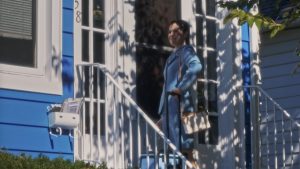
Caroline Dhavernas
HtN: I mean, there’s a very consistent look to the film, whenever it’s supposed to take place. Where did you shoot it? It could be anywhere, which is the point. You mentioned New Jersey…
AK: We shot most exteriors in her world were all shot a little bit upstate, in New York. We did 6 days up there. And then a little bit of everywhere. We kind of patched together a few towns. She has a Pennsylvania plate, but we never bring it up, so it could be anywhere, but we shot a little bit in Jersey, a little on Long Island. The bar we shot in was actually in Manhattan. We found this bar that gave us an amazing deal – T.J.’s – it was super great, because bars are very expensive to shoot in. And so that saved us. And then a little bit in Brooklyn, on a Brooklyn stage and then at a church, for the AA meeting, and we just kind of patched things together.
HtN: Who was your cinematographer?
AK: His name’s James Axel West. And he’s this great guy who came up through AFI [American Film Institute]. He works there now. And he just saved us so many times. He’s so technically savvy, yet so artful. He’s this Midwestern guy who knows Eric Rohmer and Roman Polanski, and we all have the same references. Once you have a shorthand – and he shot my two shorts – it’s just so easy. He knows the shots that I like. He knows the world it was. Once you have that relationship with the DP [director of photography], you hold on to that.
HtN: What did you shoot on?
AK: We wanted the [Arri] Alexa. We got this grant from Film Independent, the AbelCine Camera Grant, which saved us, because we had no money, and they gave us a whole camera package. And we tried to get an Alexa, but we ended up shooting on the Sony F55, which is like Sony’s version of the Alexa, and we also shot some stuff on the [Sony] FS7 and this other Panavision camera. It kind of has a film look to it.
HtN: Final question. I’m a dog person, and there’s a dog in your film, by Sherry’s motel. I was worried that something bad was going to happen to the dog, but no, the dog is just there. Where did you find the dog?
AK: (laughs) The dog was the set decorator’s sister’s dog. There was a lot more … do you want me to reveal this plot point with the dog that got cut?
HtN: Sure!
AK: So there’s a moment at the end, with the dog, where she was supposed to kick the dog, and then chase after the dog, fall in the mud (laughs hard) so we couldn’t…I realized that we weren’t able to actually do that…(laughs)…as a production, and the dog isn’t a trained dog, so that would take three days to do.
HtN: And it would really change the nature of the ending. And you might risk turning the audience against Sherry, which is fine if you want to go that route, but I’m glad you didn’t do that.
AK: Yeah! Because I love the dog. It’s like her only friend…(laughs)…not really.
HtN: Although, if she runs after it, that’s one thing. Well, Adam, thank you so much, and thanks for making the film!
AK: Thank you!
– Christopher Llewellyn Reed (@ChrisReedFilm)








